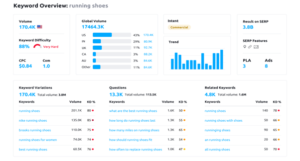There is no item in your cart

What is content marketing?
The term “Content marketing” refers to a type of marketing in which a company systematically develops and disseminates content that is designed to attract and maintain a certain target audience in order to generate a return on investment (ROI) from the customers who interact with the brand (Nagy and Hajdu, 2021). Maintaining a steady stream of content marketing helps to connect with new and current clients. Customers are more likely to make a purchase from a business if they see that business as a helpful resource and an ally in their pursuit of success.
Content Marketing Tools
Google Analytics: Marketers may get a full picture of their website’s performance with the help of Google Analytics, a web analytics tool (Maintz, 2020). How users interact with advertisements, site content, and social media tools across all platforms is crucial. With this information, webmasters may better tailor their sites’ content to attract and retain visitors.

SEMrush: It is essential to optimise the content for search engine results pages (SERPs) to be successful as a content marketer. At this point, SEMrush comes into its own as a useful tool. It is a digital marketing application that was developed specifically with SEO and SEM specialists in mind. Data on user engagement is made available to content marketers in order to assist them in achieving a better ranking in search engines. The tool is equipped with a vast SERP database that contains more than 106 million keywords and 71 million sites.

Moz: Monitoring problems that might have an impact on the effectiveness and ranking of the website is a very essential thing to do. Moz enables the company to track the rankings of the website for any term that is significant to the firm. Moz also provides services like as on-page SEO, competition analysis, and a keyword difficulty tool which are all very useful tools.

How does content marketing work?
SME businesses may maximise its usefulness by tailoring their content delivery to each step of the sales process, from first brand exposure to the final purchase decision. How content marketing is used to engage and close customers at every step of the sales cycle is shown below.
Awareness stage: The material at this point in the sales process should address the most pressing issues facing the company’s target demographic (Grinko and Golik, 2021). The greatest way for a business to connect with its customers is to write about the problems they face and the questions they have. Awareness-level content should be informative and instructional. Businesses should hold off on selling until the last stages of the deal, during consideration and closure.
Consideration stage: Content in the contemplation phase should include a mix of informative resources and promotional opportunities. Its purpose is to inform the reader of what to look for in terms of features and functions and how those characteristics might be used to meet their specific requirements (Mazurek and Sobocinska, 2020). Obviously, the focus should be on the products and services offered by the company. Case studies, how-to articles, how-to videos, checklists, and worksheets are all excellent examples of material suitable for this phase.
Closing stage: When a customer is ready to make a purchase, content marketing is crucial. Sales efforts may now be prioritised, provided the firm maintains its emphasis on what makes it the greatest option rather than just praising its own merits. Here, the company should emphasise its competence, knowledge, and the unique advantages of its products.
Why should businesses use content marketing?
To engage the target audience: Providing the audience with material they can really value will have them raving about it and spreading the word (Grinko and Golik, 2021). In addition, readers will engage with the content in other ways, such as by providing feedback in the form of responses and feedback.
To generate a positive brand image: People have a tendency to shop with brands that they are already familiar with rather than with firms that they are not familiar with, and content marketing may assist the audience at the precise time it needs assistance.
To educates consumers about products and services: The vast majority of individuals are completely unaware that they even have an issue, much alone that it can be remedied by purchasing or using the product or service. Content marketing has the ability to educate the audience about the existence of a solution as well as how it functions.
To reduces customer acquisition cost: The cost of acquiring a new customer, as measured by the Customer Acquisition Cost (CAC) statistic, often includes the combined efforts of advertising and sales departments (Nagy and Hajdu, 2021). Given that a single piece of content may potentially reach so many individuals, content marketing may have a lower CAC than other forms of advertising.
Recommendation
Identifying the target audience is a prerequisite to developing an effective content marketing plan. Creating marketing personas that reflect a target audience’s motivations and justifications for making a purchase is beneficial. That way, businesses may learn more about the interests and needs of different types of customers. The substance, however, must not be meaningless talk. Each and every one of the writing efforts should be directed at helping the readers in some manner, whether that’s by providing them with an answer to a pressing issue or offering advice that may help them in any manner.



Leave A Comment